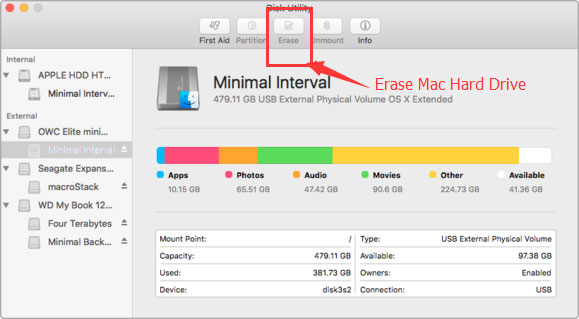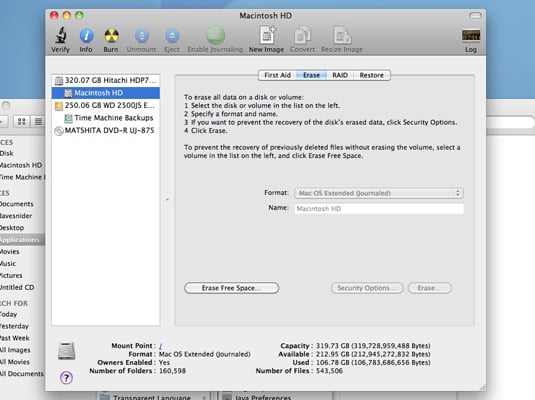To format an external hard drive for Mac with Time Machine, you must follow the steps below. Step 1 Open Finder, Applications, then go to Utilities and Disk Utility. Step 2 Follow the steps above to format the drive, and then you can use it with Time Machine on your Mac system. Part 3: Bonus Tip – Data Recovery from Formatted Hard Drive on Mac.
The 4 disk formatting software for Mac above can help you easily format hard drive, USB flash drive, memory card, and other storage media under Mac OS. However, when you format your hard drive with Super Eraser for Mac, all your data will be permanently lost. So please back up your important files before you run Super Eraser for Mac to format. For instructions on how to format a drive in Mac OS 10.11 (El Capitan) and above click here. To reformat the drive in Mac OS X: 1. Open Disk Utility ApplicationsUtilitiesDisk Utilities 2. Select the Seagate drive on the left that shows the capacity 3. Select the Partition tab on the right hand side of the Disk.
When you attach a storage disk to a Mac with the purpose of erasing or repartitioning it, you'll be presented with the option of selecting one of the three available partition maps: GUID Partition Map, Master Boot Record, and Apple Partition Map.In this article we will explain what a partition scheme is and which one to pick when formatting a drive. Option 1: Format to NTFS, and use NTFS-3G to read/write on Mac. If you keep your hard drive's out-of-the-box NTFS format for all the reasons FAT32 displeases, there's a workaround that will allow.
Erasing your disk: For most reasons to erase, including when reformatting a disk or selling, giving away or trading in your Mac, you should erase your entire disk.
Erasing a volume on your disk: In other cases, such as when your disk contains multiple volumes (or partitions) and you don't want to erase them all, you can erase specific volumes on the disk.
Erasing a disk or volume permanently deletes all of its files. Before continuing, make sure that you have a backup of any files that you want to keep.
How to erase your disk
- Start up from macOS Recovery. Then select Disk Utility from the Utilities window and click Continue.
If you're not erasing the disk your Mac started up from, you don't need to start up from macOS Recovery. Just open Disk Utility from the Utilities folder of your Applications folder. - Choose View > Show All Devices from the menu bar in Disk Utility. The sidebar now shows your disks (devices), and any containers and volumes within them. The disk your Mac started up from will be at the top of the list. In this example, Apple SSD is the startup disk:
- Select the disk that you want to erase. Can't see your disk?
- Click Erase, then complete these items:
- Name: Type the name you want the disk to have after you have erased it.
- Format: Choose APFS or Mac OS Extended (Journalled). Disk Utility shows a compatible format by default.
- Scheme: Choose GUID Partition Map.
- Click Erase to start erasing your disk, and every container and volume within it. You may be asked to enter your Apple ID. Forgotten your Apple ID?
- When it's finished, quit Disk Utility.
- If you want your Mac to be able to start up from the disk you erased, reinstall macOS on the disk.
How to erase a volume on your disk
- Start up from macOS Recovery. Then select Disk Utility from the Utilities window and click Continue.
If you're not erasing the volume your Mac started up from, you don't need to start up from macOS Recovery. Just open Disk Utility from the Utilities folder of your Applications folder. - In the sidebar of Disk Utility, select the volume that you want to erase. The volume your Mac started up from will be called Macintosh HD, unless you have changed its name. Can't see your volume?
- Click Erase, then complete these items:
- Name: Type the name you want the volume to have after you have erased it.
- Format: Choose APFS or Mac OS Extended (Journalled). Disk Utility shows a compatible format by default.
- If you see an Erase Volume Group button, the volume you have selected is part of a volume group. In that case, you should erase the volume group. Otherwise, click Erase to erase just the selected volume. You may be asked to enter your Apple ID. Forgotten your Apple ID?
- When it's finished, quit Disk Utility.
- If you want your Mac to be able to start up from the volume you erased, reinstall macOS on that volume.
Reasons to erase
You can erase at any time, including in circumstances such as these:
- You want to permanently erase all the content from your Mac and restore it to factory settings. This is one of the final steps before selling, giving away or trading in your Mac.
- You’re changing the format of a disk, such as from a PC format (FAT, ExFAT or NTFS) to a Mac format (APFS or Mac OS Extended).
- You’ve received a message that your disk isn’t readable by this computer.
- You're trying to resolve a disk issue that Disk Utility can't repair.
- The macOS installer doesn’t see your disk or can’t install on it. For example, the installer might say that your disk isn’t formatted correctly, isn’t using a GUID partition scheme, contains a newer version of the operating system or can’t be used to start up your computer.
- The macOS installer says that you may not install to this volume because it is part of an Apple RAID.
About APFS and Mac OS Extended
Best Disc Format For Mac
Disk Utility in macOS High Sierra or later can erase using either the newer APFS (Apple File System) format or the older Mac OS Extended format, and it automatically chooses a compatible format for you.
Mac Disk Format Types
How to choose between APFS and Mac OS Extended
Disk Utility tries to detect the type of storage and show the appropriate format in the Format menu. If it can’t, it chooses Mac OS Extended, which works with all versions of macOS. If you want to change the format, answer these questions:
- Are you formatting the disk that came built into your Mac?
If the built-in disk came APFS-formatted, Disk Utility suggests APFS. Don't change it to Mac OS Extended. - Are you about to install macOS High Sierra or later for the first time on the disk?
If you need to erase your disk before installing High Sierra or later for the first time on that disk, choose Mac OS Extended (Journaled). During installation, the macOS installer decides whether to automatically convert to APFS — without erasing your files. - Are you preparing a Time Machine backup disk or bootable installer?
Choose Mac OS Extended (Journalled) for any disk that you plan to use as a Time Machine backup disk or as a bootable installer. - Will you be using the disk with another Mac?
If the other Mac isn't using macOS High Sierra or later, choose Mac OS Extended (Journalled). Earlier versions of macOS won't work with APFS-formatted volumes.

How to identify the format currently being used

If you want to know which format is currently in use, use any of these methods:
- Select the volume in the Disk Utility sidebar, then check the information shown on the right. For more detail, choose File > Get Info from the Disk Utility menu bar.
- Open System Information and select Storage in the sidebar. The File System column on the right shows the format of each volume.
- Select the volume in the Finder, then choose File > Get Info from the menu bar. The Get Info window shows the Format of that volume.
If your disk or volume doesn't appear or the erase process fails
- Shut down your Mac, then unplug all non-essential devices from your Mac.
- If you're erasing an external drive, make sure it's connected directly to your Mac using a cable that you know is in good working order. Then turn the drive off and back on.
- If your disk or volume still doesn't appear in Disk Utility or Disk Utility reports that the erase process failed, your disk or Mac may need a service. If you need help, please contact Apple Support.
Learn more
- If you can't start up from macOS Recovery, you can use a different startup disk instead.
- If Disk Utility shows a Security Options button in the Erase window, you can click that button to choose between a faster (but less secure) erase and a slower (but more secure) erase. Some older versions of Disk Utility offer the option to zero all data instead. These secure-erase options aren't offered or needed for solid-state drives (SSDs) and flash storage.
by Shirly Chen, updated on 2017-02-07 to Mac Data Wipe
Formatting is a prior method to delete all data from local/external hard drive or fix disk error. For Windows users, it is very easy to format a hard drive using built-in quick format feature. However, when a Mac user right-clicks a hard drive on Mac, he can’t see the quick format option. Especially for the new Mac users, it seems difficult to find a solution to format local hard drive or external hard drive under Mac OS. In this article, we will introduce some Mac disk formatting software tools to help Mac users easily and securely format hard drive, USB flash drive, memory card or other device under Mac OS.
Three Useful Disk Formatting Software for Mac
Disc Format For Mac
1. Super Eraser for Mac - best Mac Disk Format Software
Super Eraser for Mac is a very powerful tool to permanently erase data from Mac hard drive or storage media. It can easily format hard drives, storage devices and permanently erase all the data on the targeted media. It also can format SSD hard drive and erase data under Mac OS. Free download the best Mac disk formatting software - Super Eraser for Mac.

This mode ‘Wipe Hard Drive’ will help you format a selected hard drive/device and erase all data from it. You just need to select the hard drive you want to format, and then click on 'Wipe Now' button. Then Super Eraser for Mac will help you format and erase the selected hard drive/device. Please note that all the existing data and history data on the selected hard drive will be permanently removed, can’t be recovered by any data recovery software or manual data recovery service.
This Mac hard drive formatting tool also can erase free disk space to permanently erase deleted/lost data on the hard drive. This option is used for erasing deleted files and formatted files on your Mac, without affecting the existing data.
If you are going to sell, donate your Mac/device or just want to completely remove unwanted files and fix disk errors, Super Eraser for Mac is the best Mac disk formatting tool for you. It can help you regain a brand new disk.
Note: formatted data will be permanently lost, can’t be recovered by any software or method.

2. Mac Disk Utility
Note: formatted data can be recovered by data recovery software.
Format Disc For Mac And Windows
Disk Utility is a built-in app in macOS. When you open this app, it will show all the hard drives and devices on your Mac. You can use the erase function to format a hard drive or device. However, when the hard drive has been erased by Disk Utility, most of the formatted data can be recovered by data recovery software.
3. Start Menu for Mac
Note: formatted data can be recovered by data recovery software.
Start Menu for Mac is an all-in-one Mac manager. It offers a feature – format. You can run it on your Mac, and use it to format external hard drive or device on your Mac. It is the fastest way to format an external hard drive/device under Mac OS.
4. MacClean360
MacClean360 is one of the best disk cleaning and management software for Mac OS. It offers more than 9 tools to help you optimize and manage your Mac computer. The Disk Manager tool is able to list all hard drives and external devices on your Mac. Then you can choose one of the hard drive and format it by click on 'Format' button.
Disc Format For Both Mac And Pc
The 4 disk formatting software for Mac above can help you easily format hard drive, USB flash drive, memory card, and other storage media under Mac OS. However, when you format your hard drive with Super Eraser for Mac, all your data will be permanently lost. So please back up your important files before you run Super Eraser for Mac to format your hard drive or other device under Mac OS.
FREE download DoYourData Super Eraser for Mac to help you format hard drive, external hard drive or storage media on Mac.
Related Articles
Permanently and securely erase data from hard drive or external storage device under Mac OS with certified data erasure methods.
Hot Articles

